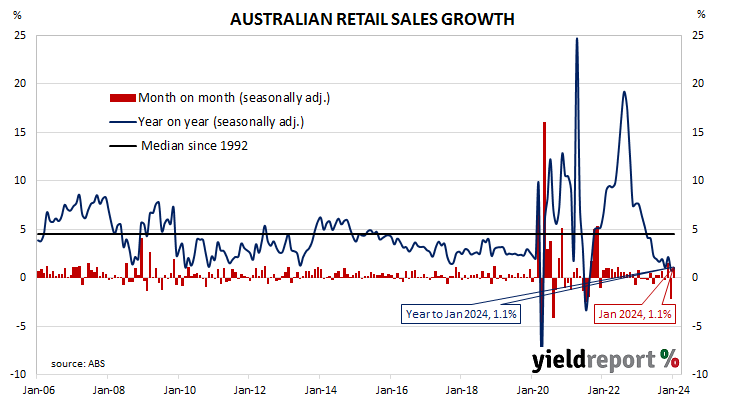Summary: Retail sales up 1.1% in January, less than expected; up 1.1% on 12-month basis; ANZ: retail sales up just 0.4% over past 3 months; ACGB yields fall; rate-cut expectations firm; Westpac: “choppy” data pattern reflects difficulties adjusting for seasonal pattern shift associated with Black Friday sales; largest influence on result again from household goods sales.
Growth figures of domestic retail sales spent most of the 2010s at levels below the post-1992 average. While economic conditions had been generally favourable, wage growth and inflation rates were low. Expenditures on goods then jumped in the early stages of 2020 as government restrictions severely altered households’ spending habits. Households mostly reverted to their usual patterns as restrictions eased in the latter part of 2020 and throughout 2021.
According to the latest ABS figures, total retail sales rose by 1.1% on a seasonally adjusted basis in January. The rise was less than the 1.5% increase which had been generally expected and it contrasted with December’s upwardly revised 2.1% loss. Sales also increased by 1.1% on an annual basis, up from December’s comparable figure of 0.8% after revisions.
“Seasonal changes due to the increasing importance of Black Friday sales have skewed the data,” said ANZ economist Madeline Dunk. “But over the three months to January retail sales grew just 0.4%, which compares to 0.4% over the same period in 2023 and 5.2% in 2022.”
Commonwealth Government bond yields moved lower on the day, largely in line with movements of US Treasury yields overnight. By the close of business, 3-year and 10-year ACGB yields had both lost 3bps to 3.70% and 4.15% respectively while the 20-year yield finished 4bps lower at 4.45%.
In the cash futures market, expectations regarding rate cuts later this year firmed. At the end of the day, contracts implied the cash rate would remain close to the current rate for the next few months and average 4.31% through March, 4.30% in April and 4.275% in May. However, August contracts implied a 4.16% average cash rate while November contracts implied 3.995%, 33bps less than the current rate.
“Sales continue move through a very choppy period,” said Westpac senior economist Matthew Hassan. “The January lift follows a sharp 2.1% drop in December and a 1.5% surge in November. The pattern reflects difficulties the ABS is having adjusting for a shift in seasonal patterns associated with the increasingly popular ‘Black Friday’ sales. Pinpointing these shifts is difficult and typically requires the accumulation of more months of observations.”
Retail sales are typically segmented into six categories (see below), with the “Food” segment accounting for 40% of total sales. However, the largest influences on the month’s total once again came from the “Household goods” segment where sales rose by 2.3% over the month.



